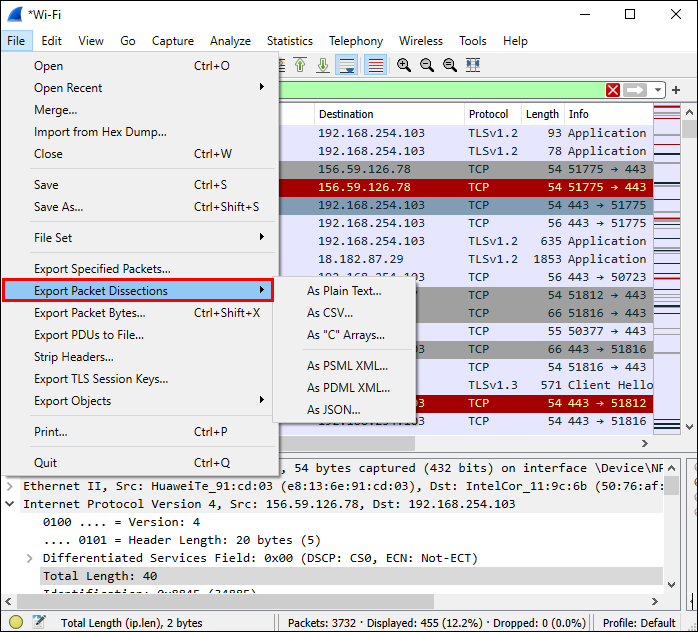Wireshark is a powerful network troubleshooting, analysis, and security auditing tool. It is a free and open-source packet analyzer that allows users to see what’s happening on their network at a microscopic level. This article will explore how Wireshark works, how to use it, and how it can benefit you.
How Does Wireshark Work?
Wireshark works by capturing packets from a network interface and analyzing them. It uses a library called libpcap to capture packets, and it can filter and analyze captured packets based on user-defined criteria. Wireshark can also decode packets and display them in a readable format, allowing users to see network traffic details.
Capturing Packets
The first step in using Wireshark is to capture network traffic. This can be done by connecting to a network interface card (NIC) and using Wireshark to monitor the traffic passing through it. Wireshark can capture packets from wired and wireless networks, as well as from network segments that are separated by switches and routers.
When capturing packets, Wireshark captures all network traffic that passes through the NIC, including both incoming and outgoing packets. This can be helpful when diagnosing network issues, as it allows you to see all the packets being transmitted and received by your computer. Additionally, Wireshark allows you to filter the captured packets based on specific criteria, such as the IP address of the source or destination, the protocol used, or the port number. This can help you focus on the most relevant packets to your analysis.
Filtering Packets
Once it captures the packets, Wireshark filters them to display only those relevant to the user. Filters can be applied to IP addresses, protocols, ports, and other criteria, allowing users to focus on specific packets of interest.
Wireshark provides a robust filtering system that allows you to narrow the packets to those most relevant to your analysis. For example, you can apply a filter to show only packets that use the HTTP protocol or are sent to a specific IP address. You can also use more complex filters that combine multiple criteria, such as packets that contain a specific string of data in the payload. Wireshark also provides a display filter, allowing you to selectively hide packets you are not interested in seeing.
Analyzing Packets
Wireshark displays the captured packets in a human-readable format, allowing users to view the details of each packet, including the protocol used, the source and destination IP addresses, the source and destination ports, and the data payload.
Once you have captured and filtered the packets, Wireshark displays them in various formats, including a summary and detailed packet views. In the summary view, Wireshark lists all the captured packets and basic information, such as the source and destination IP addresses and the protocol used. In the detailed packet view, Wireshark displays the contents of each packet, including the data payload and any headers or other metadata. This allows you to analyze each packet’s contents in detail and determine the cause of any network issues you may be experiencing.
Protocol Decoding
One of the critical features of Wireshark is its ability to decode and interpret a wide range of network protocols. With over 3,000 protocols supported, Wireshark can analyze network traffic from various sources and identify potential issues or security threats.
The tool provides detailed information on the packet structure, protocol hierarchy, and fields used in each packet, making it easy for users to understand the traffic flow. This information helps troubleshoot network issues, optimize performance, or identify potential security vulnerabilities.
Statistical Analysis
Wireshark provides a range of statistical tools to help users analyze network traffic. By collecting data on packet size, protocol distribution, and travel time between different hosts on the network, Wireshark can provide valuable insights into network performance and behavior.
This information can identify areas where network resources are underutilized or overloaded, or network traffic patterns may indicate security threats or vulnerabilities. By visualizing this data through graphs and charts, Wireshark makes it easy for users to identify trends and patterns in network traffic and take appropriate action to optimize network performance and security.
Exporting Data
Wireshark allows users to export captured data in various formats, including plain text, CSV, and XML. This feature is handy for sharing network traffic data with other analysts or importing the data into other analysis tools.
By exporting data in a standardized format, Wireshark ensures that the data can easily integrate into other analysis tools and be shared with other network security or troubleshooting team members. The tool’s ability to export data in multiple formats also makes it more versatile, enabling users to work with it in various ways depending on their specific needs and workflows.
Packet Reassembly
Another important feature of Wireshark is its ability to reassemble packets split across multiple network segments. This is particularly useful for analyzing network traffic that uses protocols such as TCP, which breaks data into multiple packets for transmission over the network.
Packet reassembly is a critical function of Wireshark that enables users to view the complete packet as it was sent across the network. When transmitted over a network, data is broken into smaller segments or packets, each with its header and payload. The packets are then sent across the network and reassembled at the destination host.
However, viewing the complete packet in its original form is often necessary when analyzing network traffic using Wireshark. This is where packet reassembly comes in. Wireshark can analyze the headers of individual packets and use the information to reassemble the original packet.
Packet Coloring
Wireshark also includes a packet coloring feature that allows users to customize the display of packets based on specific criteria. This can be useful for highlighting packets that meet specific criteria, such as those that contain errors or are related to a particular protocol. Users can create their custom color schemes or use the default color scheme provided by Wireshark.
Protocol Dissector Plugins
Wireshark allows users to create their protocol dissector plugins to decode and interpret proprietary or custom protocols. This feature can be handy for analyzing traffic in proprietary or custom protocol environments.
Expert Information
The Expert Information dialog in Wireshark monitors and highlights any irregularities or noteworthy occurrences found in a capture file. Its primary purpose is to aid both novice and experienced users identify network problems more efficiently than manually sorting through packet data.
Remember that Expert Information is just a hint and should be used as a starting point for further investigation. Since every network is unique, it’s up to the user to confirm that Wireshark’s Expert Information is relevant to their specific scenario. The presence of Expert Information does not always indicate a problem, and the lack of Expert Information does not necessarily mean everything is functioning correctly.
How to Use Wireshark
To use Wireshark, follow these simple steps:
- Download and install Wireshark on your computer by visiting the official Wireshark website.

- Open Wireshark on your computer.

- Select the network interface from which you want to capture packets. This could be your Wi-Fi connection, Ethernet connection, or any other network connection on your computer.

- Once you select the network interface, capture packets by clicking the Capture button. You can stop capturing packets anytime by clicking the Stop button.


- Wireshark will capture all packets that pass through the selected network interface. You can then use Wireshark’s powerful filtering options to analyze specific packets or types of packets.

- To filter packets, enter a filter expression in the filter bar. Wireshark will display only the packets that match the filter expression.

- Wireshark also provides a range of powerful analysis tools that you can use to understand the captured packets in more detail. Wireshark can analyze packet headers, packet payloads, packet timing, and more.

- Once you have analyzed the captured packets, you can export the data in various formats using Wireshark’s export options. This makes it easy to share data with other analysts or to import data into other analysis tools.

Note that interpreting packet captures can be complex, and attempting to remove or mitigate issues based solely on packet capture data may not be successful.
Benefits of Wireshark
Wireshark has several benefits, including:
- Troubleshooting network issues: Wireshark can help you identify and troubleshoot issues like slow network performance, packet loss, and congestion.
- Analyzing network traffic: Wireshark can be used to analyze network traffic and understand how applications communicate with each other over a network.
- Network security auditing: Wireshark can detect network security vulnerabilities and potential attacks.
- Educational purposes: Wireshark can be a learning tool to understand how network protocols work and how data transmits over a network.
Insightful Networking
Wireshark is a powerful tool for network analysis and troubleshooting. It allows users to capture, filter, and analyze packets in real-time, making it an invaluable tool for network administrators, security professionals, and anyone interested in understanding how networks work. By understanding how Wireshark works and its benefits, you can leverage it to improve your network performance and security.
With Wireshark, you’ll have the tools to troubleshoot network issues, analyze network traffic, and improve network security. Use the comment section below to tell us more about your experience exploring your network traffic with Wireshark.
Disclaimer: Some pages on this site may include an affiliate link. This does not effect our editorial in any way.















